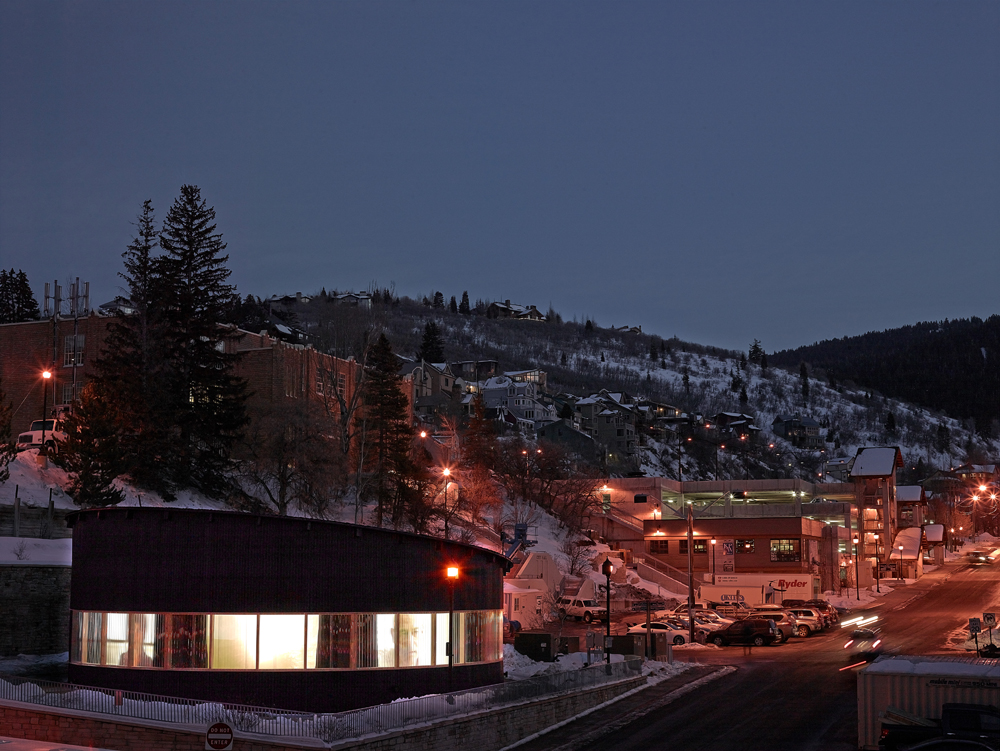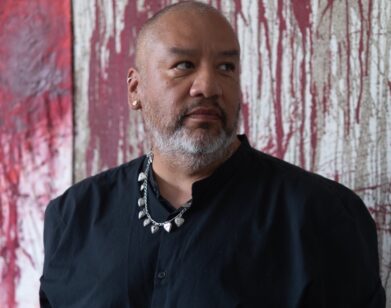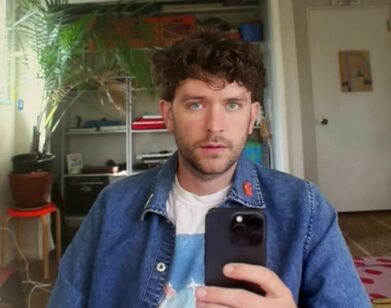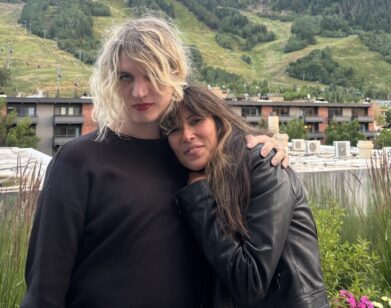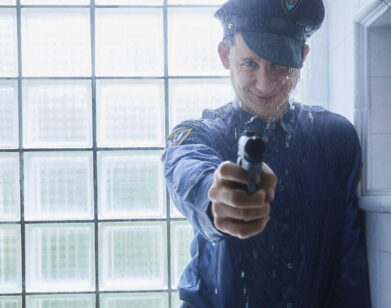Exclusive Preview and Interview: ‘The Source (evolving),’ Doug Aitken
“I’d really like to make this a living project—a living artwork that doesn’t really have an end,” says installation artist Doug Aitken of his newest undertaking, The Source (evolving), a sprawling network of four-minute video interviews with artistic luminaries on the subject of the creative impulse. “I love this idea that something can kind of grow, and this dialogue can expand, and it can be democratized and given away. And anyone can take a piece of it, and agree with it or disagree with it.”
After premiering at the Tate Liverpool last year, The Source (evolving) makes its U.S. debut today in Park City, Utah, in conjunction with the Sundance Film Festival’s New Frontier program, which supports and showcases films that challenge and expand traditional narrative structures in storytelling in favor of entirely new viewer experiences. Aitken has been involved with the program since 2008, when he adapted his popular and acclaimed Sleepwalkers to be shown in a Main Street basement at the festival.
“Doug Aitken, as an artist and as an explorer of humanity, is a kind of soulmate of New Frontier,” explains New Frontier’s curator, Shari Frilot. “Today, we live in an age of expanded cinema where everyday we move through and fully immersive media environment. The Source (evolving) beautifully embodies the spirit of this expanded cinema by bringing monumental form and interactivity with the moving image to the streets and the very air of Park City. It is incredible to have Doug back to New Frontier on the occasion of the 30th anniversary of Sundance with his astonishing work.”
Throughout Sundance, The Source (evolving) will physically live in a specially-designed, 2000-square-foot standalone circular structure, created in collaboration with one of Aitken’s subjects, the architect David Adjaye. Six-channel video projections of the installation are projected across the walls of the building’s interior; unsurprisingly, for fans of Sleepwalkers, the videos will also be projected onto the outer walls of the structure and visible from its exterior. Aitken has also developed a website to serve as home for the interviews, whose 22 subjects thus far include William Eggleston, Ryan Trecartin, Richard Phillips, Paolo Soleri, James Murphy, Jack White, Mike Kelley, Devendra Banhart, Beck, Tilda Swinton, Alice Waters, and James Turrell. Though the physical exhibition ends next Saturday, Aitken plans to continue to update the website with new conversations indefinitely. We’re excited to premiere a video preview of the project below, followed by our conversation with Aitken about the work.
ALEXANDRIA SYMONDS: Hi, Doug, are you in Park City already?
DOUG AITKEN: I am, I’m just getting the snow. It’s crisp. [laughs]
SYMONDS: It’s such an exciting exhibition that you’re mounting. How are you feeling right now about it?
AITKEN: Oh, I think it’s almost there. It’s been a very organic project; I’ve been working on it for maybe three or four years. And initially, it was really casual—it was really just kind of tracking down certain people, having conversations that were always focused on creativity, the starting point of what you make, before the aesthetics or the materials exist. Seeing it go from there to, now, this completed pavilion is kind of amazing.
SYMONDS: You’re planning to continue the project too, right?
AITKEN: Yeah, it’s an ongoing project.
SYMONDS: How did you choose your subjects? Were any of them friends of yours already, or did you just make a dream list of amazing, creative people you wanted to talk to? Did you already know people like Richard Phillips and Ryan Trecartin and Tilda and Beck?
AITKEN: Those people I knew, but there were some people I didn’t know. I wanted the project to grow in a very organic way, and not be focused purely on one medium, you know? In equal parts, you find musicians, Terry Riley, or Jack White, or Lucky Dragons, or you find architects like David Adjaye or Paolo Soleri or Jaques Herzog, and artists—[I want to] really kind of bring it all back to one place, one starting point, and ignore the ghettos that are created out of culture. One of the things this project looks to [do] is to break away from this idea, this kind of cultural segregation that you find, where music is way over here, and it’s written about by certain authors and covered by certain sites or journals, and separate from that is art. The interesting thing I found on this project really was that there’s so much commonality to where ideas really begin, and where concepts really kind of start from.
It’s interesting, because if you strip away the mediums—in this project that opens tomorrow, there’s 22 different individuals— you find that there are certain things that kind of recur, certain ideas that come up again and again in different ways. For me, that was kind of amazing, because there’s this complete spectrum of chaos and order that people look to, to frame their work, or to use as a process. That might be something like Jack White talking about growing up near factories in Detroit, and hearing the factory sound, and how that influences his rhythms—and then James Murphy, who’s making electronic music, talks about being on the floor of the kitchen, listening his mom’s refrigerator, the hum of it. It’s interesting that there are these different ideas that are in the air, that are used by a lot of people, but all of them in a very personal way. That was the thing that surfaced out of the project, The Source, that surprised me.
SYMONDS: Even in just the trailer, it seemed like there were a couple of threads that come up again and again; this idea of creativity as a way of organizing or shaping chaos seemed to be one of them. Was there anything else?
AITKEN: I think it’s also the process. I think the idea of embracing the process, creating something, no matter how thin it is, that you can call a starting point—whether it’s a word or it’s an idea, or it’s a little piece of narrative that you might base a film on— starting that journey of making the work. That’s also something that every individual does very differently. Some people just want to step into it. You see someone like maybe William Eggleston. William doesn’t even really talk about what he does; he just wants to make these images. He kind of hovers around a location and extracts these images. Maybe it’s Liz Diller, who is making architecture, but she’s not thinking about the architecture, necessarily—she’s thinking about the area, the region, the city, the country, how this whole thing fits into this incredible system of gears and cogs, and how she can really make something work with that. I think the project also really looks to individuals, to try to find what’s unique about each person in the work. What’s their voice? What kind of risks are they willing to take? What kind of failure are they willing to accept?
SYMONDS: Several of your subjects communicated the goals of their work through other mediums. David Adjaye, the architect, described his work as creating something like complete fictions, and then Richard Phillips compared his process of painting to architecture. It creates this really cool chain in the project.
AITKEN: Yeah, I think that’s one of the things the project explores. Our culture is just too comfortable in creating these kind of divisions between culture…
SYMONDS: Compartmentalizing?
AITKEN: Exactly, the compartmentalizing is so severe, that we kind of lose track. When you sit down to dinner with friends, you’re going to talk about everything, sharing this polyphony of experiences, this spectrum of culture, and it’s all cross-pollinating all the time. It’s in this kind of huge beehive. It’s not this precious thing, it’s just this dirty beehive with things moving around, creating accidents, and violence, and harmony. It’s this kind of beautiful mess, this matter. I think that’s really what surfaces out of this project. It might be David Adjaye talking about how the structure of jazz music informs his architecture, it might be the musician Terry Riley talking about how he thinks so much about cinema. I’d love to see more of a rupture between mediums and a flow between them.
SYMONDS: A project like this, even, it seems like it would be hard to call it any one thing. It seems to me like it’s a kind of journalism, because those are terms in which I’m very used to thinking about things, and I’m sure that a video artist would think of it as video art. How do you see it?
AITKEN: Well, I guess I started the project originally with no real direction. I just realized that I would occasionally have conversations with certain friends who were making things, and I was really interested in what they did. If I had a camera, I thought it was important to turn it on them, and to just really hear them talk about what they made. I didn’t really know what I’d do with it, I didn’t have any kind of plan or anything, but I started recording conversations and they started building, more and more and more. As I listened to them I realized how diverse they were, and within the diversity there’s also these kinds of threads that would recur. I felt that it was almost like we were somehow weaving this fabric of ideas together. The denser it got, the more voices that were a part of it, it became more interesting, and more compelling. I think the project really came out of that. It came out of this idea of putting the camera on someone and just giving them their space to really explain in their own words how they came to what they’re doing, and where it’s going, in a way that was casual, and raw, and unmediated.
SYMONDS: When you’re having these conversations, how much time do you spend talking versus listening? Do you feel it’s helpful to ground your subject with your own thoughts on what they’re saying, or does that impede the flow of what’s coming out of them?
AITKEN: I try to be very open. I’m not a journalist; I’m probably a horrible interviewer. The one small thing I have is I’m curious, and I’m interested in who I’m with. I try to just put a blank stage in front of them, and say, “This is your space; you tell me where you’re coming from and where you’re going.” At a certain point, it was interesting as the project started to become what it is now, The Source, which has a physical installation and also an online presence. As we started building the installation, I started thinking, “It’s really strange that we’re building this installation, this piece of architecture you can go into.” It’s almost strange because I suppose it’s an artwork, but it’s an artwork that’s really constructed out of ideas. There’s no real textural artwork that’s made here. So could the ideas be the architecture? As opposed to, “This is a piece which is authored by one person.” I think this is really this kind of collection of ideas, this kind of system. What The Source becomes, in a physical sense, is almost like this particle accelerator. There’s all these different, discrete voices and ideas. If you just saw two of them together perhaps it might seem completely diverse and like, “Why do you have these two people together?” But as it grows and as it speeds up, it kind of creates a larger dialogue.
SYMONDS: One thing I noticed was how naturalistic the settings where the conversations took place were. You’re just wearing a t-shirt and drinking a coffee. To see that displayed in this very consciously constructed space—it seems like it would create the question in the viewer’s mind of, “What is the space for this art?”
AITKEN: Yeah, absolutely. Also, every conversation is distilled to four minutes, so they’re all the exact same format—however, it really creates a road trip through ideas, because each person we’ve shot in a totally different place. Whether it’s Paolo Soleri, before he passed away, in Arcosanti in Arizona, the utopian city he built, or it’s Jacques Herzog in his studio in Basel, Switzerland. You could not have more opposing environments [laughs] than these kind of random structures in the Southwest, versus this clean, organized Swiss studio. But somehow when they’re juxtaposed, you feel this tension and you also feel a connection. I think embracing that idea of being on the road in the piece was something that was really important for us, because it opened things up, and it didn’t become a kind of question-and-answer situation. It became more about, “We all live in our own environment; let’s allow that to be part of this.”
SYMONDS: How long, typically, were the conversations that you were breaking down to their most essential four-minute kernels?
AITKEN: They probably ranged between an hour and a couple hours.
SYMONDS: Wow. That’s really hard to do.
AITKEN: [laughs]
SYMONDS: As the project grows and becomes its own entity, do you find yourself, if someone says something that you’ve heard in some version before, wanting to say, “Oh! That reminds me of what Tilda said!”?
AITKEN: So the website will launch this week, and it will contain all the conversations. When it goes out, we just want to kind of give it away, to have this artist-driven project that anyone, anywhere can tap into and view. At the same time, I didn’t want a passive experience for that. If you find yourself listening to a certain conversation with someone and a certain idea has come to the surface, on the site, you could follow that idea, and that will lead you through all the different times with different people that subject was explored.
SYMONDS: Oh, wow.
AITKEN: For example, you mentioned chaos. So, it might go from Ryan Trecartin talking about chaos, to Mike Kelley talking about chaos, to Tilda Swinton, to someone else, to someone else. So at its best, on the site, you can really create your own film out of the ideas that you’re most interested in.
SYMONDS: I could spend all day doing that.
AITKEN: Yeah. [laughs] It just felt important, in the same way that the physical installation was designed, architecturally. You could walk in, and stand in the middle and see six screens, and hear this kind of polyphony of voices. Or you could walk over and just be with that one person, and sit through that one person’s world of ideas, hearing it, really, in their own voice. So I wanted that sense of empowerment for the viewer. I’m not a journalist, I’m not on television; I’m used to making artwork. So I wanted something that would empower the viewer to really make their own story, or allow them author their own experience, out of everything that we’ve harvested for the project.
THE SOURCE (EVOLVING) WILL BE ON DISPLAY AT NEW FRONTIER, 136 HERBER AVENUE, PARK CITY, UTAH, FROM NOON TO 8 PM TODAY THROUGH JANUARY 24 AND FROM NOON TO 3 PM ON SATURDAY, JANUARY 25. FOR MORE INFORMATION, VISIT THE SUNDANCE WEBSITE.

